
Concept explainers
(a)
Interpretation:
The most acidic proton, in the given species, is to be identified, and its pKa value is to be estimated.
Concept introduction:
An Acidic proton is one which is directly bonded to an electronegative atom. The acidity of a compound is governed largely by the
Answer to Problem 6.50P
The most acidic proton in the given species along with its estimated pKa value is:
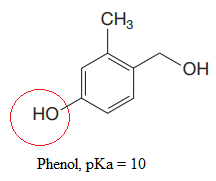
Explanation of Solution
The structure for the given compound is:
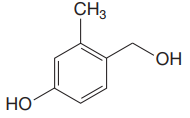
There are three protons that could be acidic. The proton attached to the carbon in methyl group, to the oxygen atom in alcohol, and the proton directly attached to the oxygen atom in phenol functional group are the protons that could be acidic.
According to Table 6-1, the relative pKa value of each of the protons is:
The pKa value for the compound having
The pKa value for the compound having
The pKa value for the compound having
Lower the pKa value, stronger is the acid, and the proton associated with it is the most acidic proton. The lowest pKa value is for

The most acidic proton in the given structure is identified along with its estimated pKa value using Table 6-1.
(b)
Interpretation:
The most acidic proton in the given species is to be identified and its pKa value is to be estimated.
Concept introduction:
An Acidic proton is the one which is directly bonded to an electronegative atom. The acidity of a compound is governed largely by the functional group on which the acidic proton is found. Nearby structural features such as highly electronegative substituent or presence of a double or triple bond can alter the acidity significantly. The pKa value for a particular compound is explained based on structural similarities of the compound and the compounds listed in Table 6-1.
Answer to Problem 6.50P
The most acidic proton in the given species along with its estimated pKa value is:
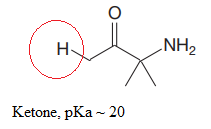
Explanation of Solution
The structure for the given compound is:

In the given structure, the proton attached to the nitrogen atom, and to the carbon atom next to the carbonyl group, could be the acidic protons.
According to Table 6-1, the relative pKa value of each of the protons is:
The pKa value for the compound having
The pKa value for the compound having
Lower the pKa value, stronger is the acid, and the proton associated with it is the most acidic proton. The lowest pKa value is for

The most acidic proton in the given structure is identified along with its estimated pKa value using Table 6-1.
(c)
Interpretation:
The most acidic proton in the given species is to be identified and its pKa value is to be estimated.
Concept introduction:
An Acidic proton is the one which is directly bonded to an electronegative atom. The acidity of a compound is governed largely by the functional group on which the acidic proton is found. Nearby structural features such as highly electronegative substituent or presence of a double or triple bond can alter the acidity significantly. The pKa value for a particular compound is explained based on structural similarities of the compound and the compounds listed in Table 6-1.
Answer to Problem 6.50P
The most acidic proton in the given species along with its estimated pKa value is:

Explanation of Solution
The structure for the given compound is:

There are two protons that could be acidic. The proton attached to the oxygen atom which is directly bonded to the carbonyl group, and to the sulfur atom are the protons that could be acidic.
According to Table 6-1, the relative pKa value of each of the protons is:
The pKa value for the compound having
The pKa value for the compound having
Lower the pKa value, stronger is the acid and the proton associated with it is the most acidic proton. The lowest pKa value is for

The most acidic proton in the given structure is identified along with its estimated pKa value using Table 6-1.
(d)
Interpretation:
The most acidic proton in the given species is to be identified and its pKa value is to be estimated.
Concept introduction:
An Acidic proton is the one which is directly bonded to an electronegative atom. The acidity of a compound is governed largely by the functional group on which the acidic proton is found. Nearby structural features such as highly electronegative substituent or presence of a double or triple bond can alter the acidity significantly. The pKa value for a particular compound is explained based on structural similarities of the compound and the compounds listed in Table 6-1.
Answer to Problem 6.50P
The most acidic proton in the given species along with its estimated pKa value is:
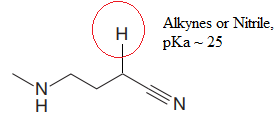
Explanation of Solution
The structure for the given compound is:

In the given structure, the proton attached to the nitrogen atom and to the triple bonded carbon atom could be the acidic protons.
According to Table 6-1, the relative pKa value of each of the protons is:
The pKa value for the compound having
The pKa value for the compound having
Lower the pKa value, stronger is the acid and the proton associated with it is the most acidic proton. The lowest pKa value is for

The most acidic proton in the given structure is identified along with its estimated pKa value using Table 6-1.
(e)
Interpretation:
The most acidic proton in the given species is to be identified and its pKa value is to be estimated.
Concept introduction:
An Acidic proton is the one which is directly bonded to an electronegative atom. The acidity of a compound is governed largely by the functional group on which the acidic proton is found. Nearby structural features such as highly electronegative substituent or presence of a double or triple bond can alter the acidity significantly. The pKa value for a particular compound is explained based on structural similarities of the compound and the compounds listed in Table 6-1.
Answer to Problem 6.50P
The most acidic proton in the given species along with its estimated pKa value is:
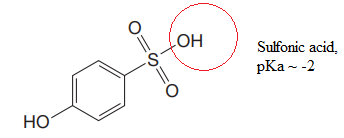
Explanation of Solution
The structure for the given compound is:

There are two protons that could be acidic. The proton attached to the carbon in methyl group, to the oxygen atom in alcohol, and the proton directly attached to the oxygen atom in phenol functional group are the protons that could be acidic.
According to Table 6-1, the relative pKa value of each of the protons is:
The pKa value for the compound having
The pKa value for the compound having
Lower the pKa value, stronger is the acid and the proton associated with it is the most acidic proton. The lowest pKa value is for

The most acidic proton in the given structure is identified along with its estimated pKa value using Table 6-1.
(f)
Interpretation:
The most acidic proton in the given species is to be identified and its pKa value is to be estimated.
Concept introduction:
An Acidic proton is the one which is directly bonded to an electronegative atom. The acidity of a compound is governed largely by the functional group on which the acidic proton is found. Nearby structural features such as highly electronegative substituent or presence of a double or triple bond can alter the acidity significantly. The pKa value for a particular compound is explained based on structural similarities of the compound and the compounds listed in Table 6-1.
Answer to Problem 6.50P
The most acidic proton in the given species along with its estimated pKa value is:
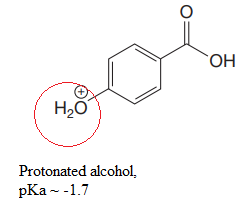
Explanation of Solution
The structure for the given compound is:
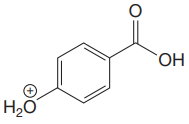
There are two protons that could be acidic. The proton attached to the carbon in methyl group, to the oxygen atom in alcohol, and the proton directly attached to the oxygen atom in phenol functional group are the protons that could be acidic.
According to Table 6-1, the relative pKa value of each of the protons is:
The pKa value for the compound having protonated
The pKa value for the compound having
Lower the pKa value, stronger is the acid and the proton associated is the most acidic proton. The lowest pKa value is for protonated

The most acidic proton in the given structure is identified along with its estimated pKa value using Table 6-1.
(g)
Interpretation:
The most acidic proton in the given species is to be identified and its pKa value is to be estimated.
Concept introduction:
An Acidic proton is the one which is directly bonded to an electronegative atom. The acidity of a compound is governed largely by the functional group on which the acidic proton is found. Nearby structural features such as highly electronegative substituent or presence of a double or triple bond can alter the acidity significantly. The pKa value for a particular compound is explained based on structural similarities of the compound and the compounds listed in Table 6-1.
Answer to Problem 6.50P
The most acidic proton in the given species along with its estimated pKa value is:

Explanation of Solution
The structure for the given compound is:

In the given structure, the proton attached to both nitrogen atoms could be acidic protons.
According to Table 6-1, the relative pKa value of each of the protons is:
The pKa value for the compound having protonated
The pKa value for the compound having
Lower the pKa value, stronger is the acid and the proton associated with it is the most acidic proton. The lowest pKa value is for protonated

The most acidic proton in the given structure is identified along with its estimated pKa value using Table 6-1.
(h)
Interpretation:
The most acidic proton in the given species is to be identified and its pKa value is to be estimated.
Concept introduction:
An Acidic proton is the one which is directly bonded to an electronegative atom. The acidity of a compound is governed largely by the functional group on which the acidic proton is found. Nearby structural features such as highly electronegative substituent or presence of a double or triple bond can alter the acidity significantly. The pKa value for a particular compound is explained based on structural similarities of the compound and the compounds listed in Table 6-1.
Answer to Problem 6.50P
The most acidic proton in the given species along with its estimated pKa value is:
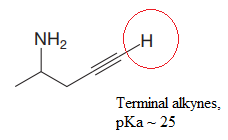
Explanation of Solution
The structure for the given compound is:

In the given structure, the protons attached to the terminal triple bonded carbon atom and to the nitrogen atom could be acidic protons.
According to Table 6-1, the relative pKa value of each of the protons is:
The pKa value for the compound having protonated
The pKa value for the compound having
Lower the pKa value, stronger is the acid and the proton associated with it is the most acidic proton. The lowest pKa value is for

The most acidic proton in the given structure is identified along with its estimated pKa value using Table 6-1.
Want to see more full solutions like this?
Chapter 6 Solutions
Organic Chemistry: Principles And Mechanisms
- Predict the major products of this organic reaction: 1. LDA (-78°C) ? 2. Br Some notes: • Draw only the major product, or products. You can draw them in any arrangement you like. . • Be sure to use wedge and dash bonds where necessary, for example to distinguish between major products that are enantiomers. • If there are no products, just check the box under the drawing area. No reaction. Click and drag to start drawing a structure. Xarrow_forwardPlease draw the structuresarrow_forwardDraw the missing intermediates 1 and 2, plus the final product 3, of this synthesis: 0 1. Eto 1. Eto- 1 2 2. MeBr 2. EtBr H3O+ A 3 You can draw the three structures in any arrangement you like. Explanation Check Click and drag to start drawing a structure.arrow_forward
- Draw the missing intermediate 1 and final product 2 of this synthesis: 1. MeO- H3O+ 1 2 2. PrBr Δ You can draw the two structures in any arrangement you like. Click and drag to start drawing a structure.arrow_forwardWhat is the differences between: Glyceride and phosphoglyceride Wax and Fat Soap and Fatty acid HDL and LDL cholesterol Phospho lipids and sphingosine What are the types of lipids? What are the main lipid components of membrane structures? How could lipids play important rules as signaling molecules and building units? The structure variety of lipids makes them to play significant rules in our body, conclude breifly on this statement.arrow_forwardWhat is the differences between DNA and RNA for the following: - structure - function - type What is the meaning of: - replication - transcription - translation show the base pair connection(hydrogen bond) in DNA and RNAarrow_forward
- What is the IP for a amino acid- give an example what are the types of amino acids What are the structures of proteins The N-Terminal analysis by the Edman method shows saralasin contains sarcosine at the N-terminus. Partial hydrolysis of saralasin with dilute hydrochloric acid yields the following fragments: Try-Val-His Sar-Arg-Val His-Pro-Ala Val- Tyr- Val Arg-Val-Tyr What is the structure of saralasin?arrow_forwardWhat is the IP for a amino acid- give an example what are the types of amino acids What are the structures of proteins The N-Terminal analysis by the Edman method shows saralasin contains sarcosine at the N-terminus. Partial hydrolysis of saralasin with dilute hydrochloric acid yields the following fragments: Try-Val-His Sar-Arg-Val His-Pro-Ala Val- Tyr- Val Arg-Val-Tyr What is the structure of saralasin?arrow_forward> aw the missing intermediates 1 and 2, plus the final product 3, of this synthesis: 1. Eto 1. EtO¯ H3O+ 1 2 2. PrBr 2. PrBr Δ You can draw the three structures in any arrangement you like. 3 Click and drag to start drawing a structure. Explanation Check 2025 McGraw Hill LLC. All Rights Reserved. Terms of Use Privacarrow_forward
- There are various factors that affect an equilibrium. Give 3 of these factors and explain using examples andequations how an equilibrium is affected by these factors. Please remember that this is a communication question so that you are communicating your understanding of the factors that affect and equilibrium.arrow_forwardEEZE LETCHUP ID Draw the most likely conjugate base resulting from this acid-base reaction. Include all lone pairs. Ignore inorganic byproducts. Drawing く NaOCH2CH3 :0: :0: 狗arrow_forwardAnswerarrow_forward
 Organic Chemistry: A Guided InquiryChemistryISBN:9780618974122Author:Andrei StraumanisPublisher:Cengage Learning
Organic Chemistry: A Guided InquiryChemistryISBN:9780618974122Author:Andrei StraumanisPublisher:Cengage Learning Organic ChemistryChemistryISBN:9781305580350Author:William H. Brown, Brent L. Iverson, Eric Anslyn, Christopher S. FootePublisher:Cengage Learning
Organic ChemistryChemistryISBN:9781305580350Author:William H. Brown, Brent L. Iverson, Eric Anslyn, Christopher S. FootePublisher:Cengage Learning

